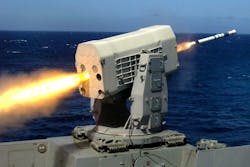Navy asks Raytheon to build Rolling Airframe Missiles for shipboard air defense against aircraft and boats
WASHINGTON – Shipboard missile-defense experts at Raytheon Technologies Corp. (RTX) will provide the U.S. and German navies with launch systems for the Rolling Airframe Missile (RAM) to protect surface warships from aircraft, missiles, and small surface vessels, under terms of a $57.3 million order announced in late June.
Officials of the Naval Sea Systems Command in Washington are asking RTX Raytheon in Tucson, Ariz., to provide RAM MK 49 Mod 5 Guided Missile Launching Systems (GMLSs).
The air-defense RAM and the MK 49 launcher and support equipment make up the RAM MK 31 Guided Missile Weapon System (GMWS). Raytheon will provide material, fabricate parts, assemble, test, and deliver RAM MK 49 Mod 5 GMLSs, GMLS ordnance alteration kits, and spare parts.
RAM is a ship self-defense weapon designed to protect Navy surface warships ships of all sizes, ranging from 500-ton fast attack craft to 95,000-ton aircraft carriers.
A supersonic, lightweight, quick-reaction, fire-and-forget weapon, the RAM missile system is designed to attack enemy helicopters, aircraft, and surface craft. It uses passive RF and infrared guidance for engaging several threats simultaneously.
RAM Block 2 for shipboard use has a large rocket motor, advanced control section, and an enhanced RF receiver able to detect quiet threat emitters. It is more maneuverable and longer range than its predecessors.
The MK 44 guided missile round pack and the MK 49 guided missile launching system together hold 21 missiles. Existing shipboard sensors can provide the system with target and pointing information.
The MK 44 missile, also part of the SeaRAM anti-ship missile defense system, is replacing the M601A1 Gatling gun in the Phalanx close-in weapon system with an 11-round launcher.
The Phalanx system’s infrared sensor suite and internal combat management system reduces its dependence on the ship’s combat system and enables a fast reaction.
The RAM is an international cooperative program between the U.S. and Germany. Raytheon shares development, production, and maintenance with the German companies MBDA Missile Systems in Schrobenhausen, Germany; Diehl BGT Defence (DBD) in Überlingen, Germany; and RAM-System GmbH (RAMSYS) in Ottobrunn, Germany.
On this contract Raytheon and its partners will do the work in Work will be performed in Ottobrunn, Germany; Tucson, Ariz.; Huntsville, Ala.; Louisville, Ky.; Moorepark, Calif.; Moonachie, N.J.; Berryville, Ark.; Tulsa, Okla.; Miami; and other U.S. locations, and should be finished by July 2026.
For more information contact RTX Raytheon online at www.rtx.com/raytheon, or Naval Sea Systems Command at www.navsea.navy.mil.
About the Author
John Keller
Editor-in-Chief
John Keller is the Editor-in-Chief, Military & Aerospace Electronics Magazine--provides extensive coverage and analysis of enabling electronics and optoelectronic technologies in military, space and commercial aviation applications. John has been a member of the Military & Aerospace Electronics staff since 1989 and chief editor since 1995.
